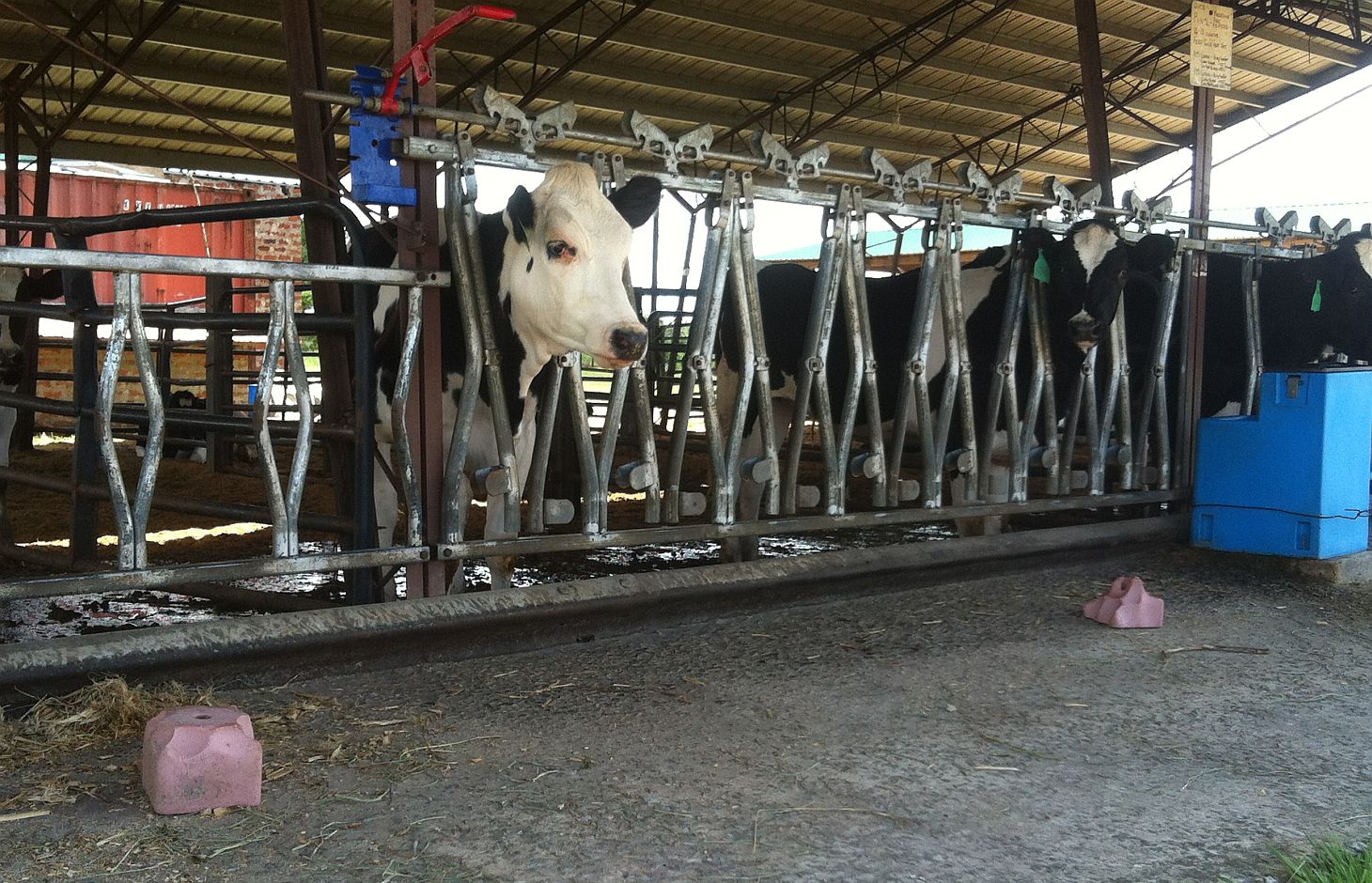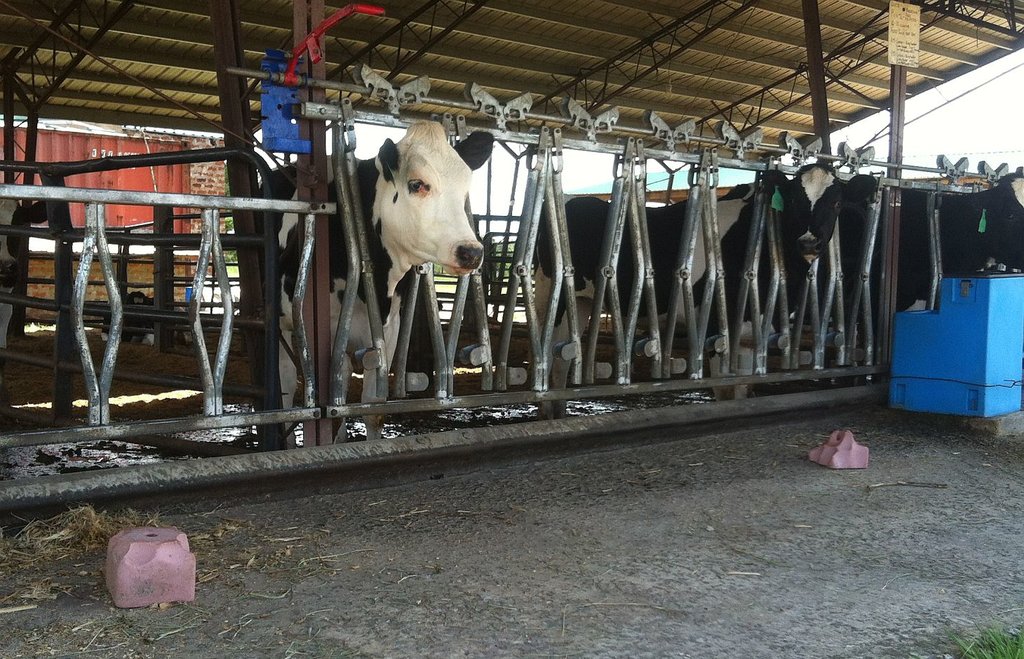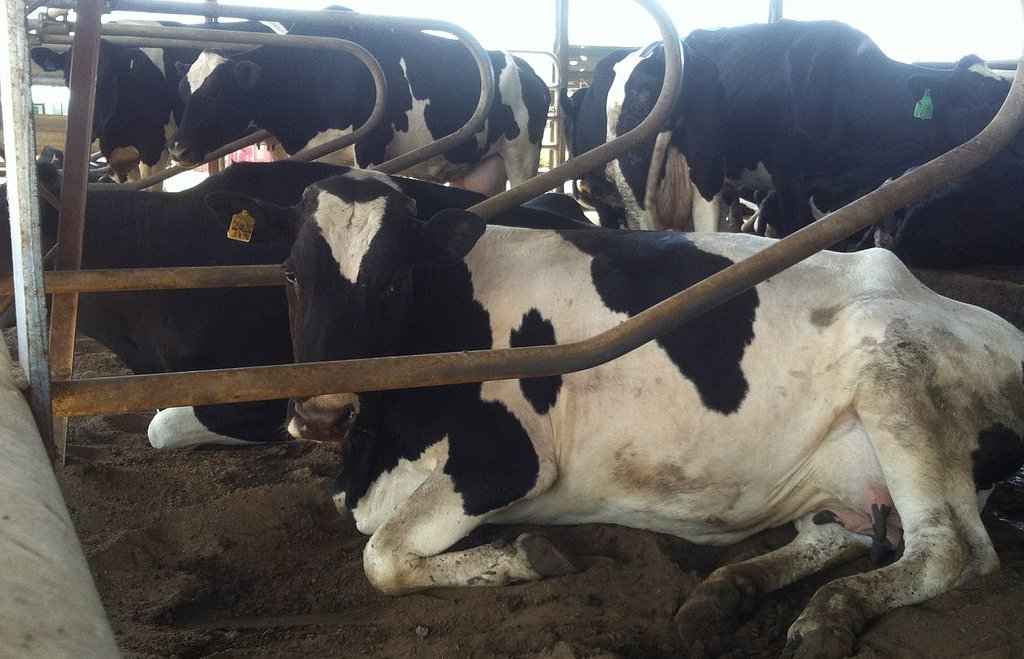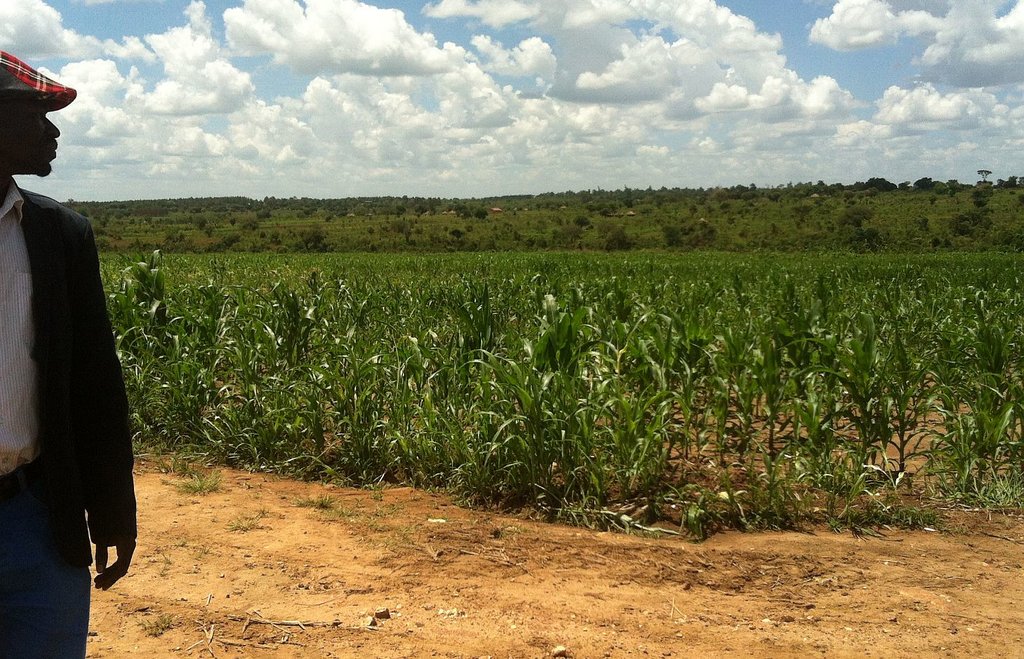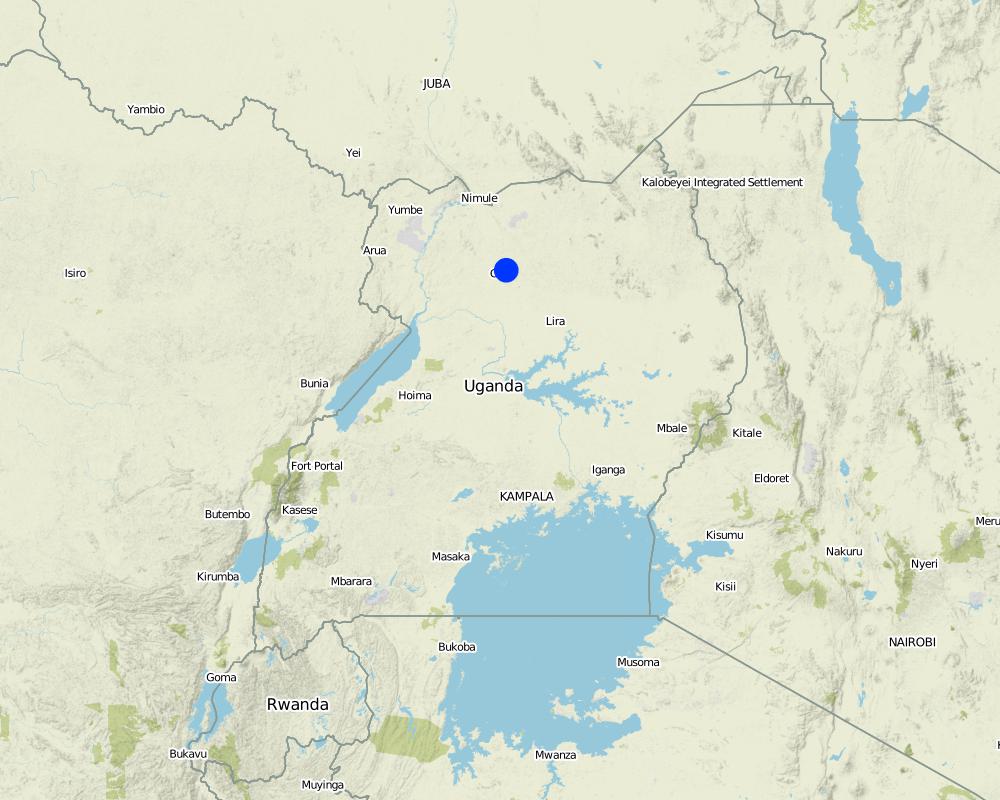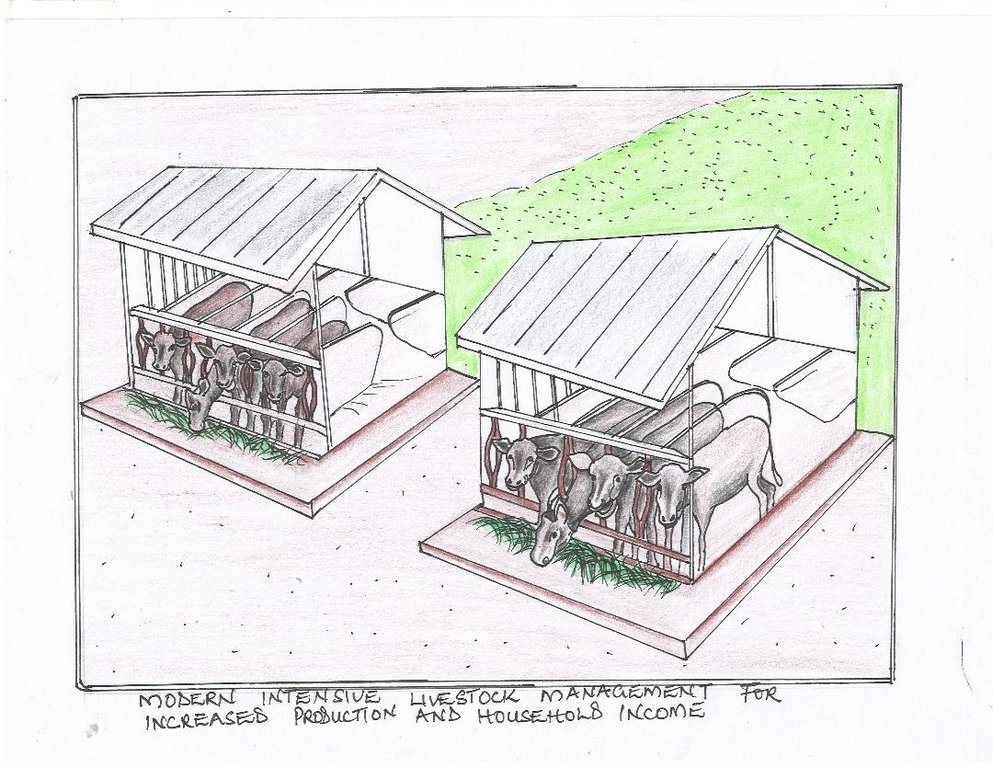Modern Intensive Livestock Management. [乌干达]
- 创建:
- 更新:
- 编制者: Kamugisha Rick Nelson
- 编辑者: JOY TUKAHIRWA, Richard Otto Kawawa, Sunday Balla Amale, Bernard Fungo
- 审查者: John Stephen Tenywa, Nicole Harari, Renate Fleiner, Stephanie Jaquet, Alexandra Gavilano, Donia Mühlematter
Gwoko dyang cak
technologies_2143 - 乌干达
查看章节
全部展开 全部收起1. 一般信息
1.2 参与该技术评估和文件编制的资源人员和机构的联系方式
关键资源人
SLM专业人员:
Sabiti Kidega Faith
Gulu Uganda Country Diary Farm
P.O box 388, Gulu Uganda
有助于对技术进行记录/评估的项目名称(如相关)
Scaling-up SLM practices by smallholder farmers (IFAD)有助于对技术进行记录/评估的机构名称(如相关)
CDE Centre for Development and Environment (CDE Centre for Development and Environment) - 瑞士1.3 关于使用通过WOCAT记录的数据的条件
(现场)数据是什么时候汇编的?:
27/04/2017
编制者和关键资源人员接受有关使用通过WOCAT记录数据的条件。:
是
1.4 所述技术的可持续性声明
这里所描述的技术在土地退化方面是否存在问题,导致无法被认为是一种可持续的土地管理技术?:
否
注释:
A highly successful example intensive zero-grazing of dairy cattle. The hybrid stock is progressively adopted to the climatic conditions of northern Uganda using selective gene replication technologies. Only female calves are produced on this farm through artificial insemination using sexed semen. Between February and April 2017, the herd increased from 54 to 63.
2. SLM技术的说明
2.1 技术简介
技术定义:
Intensive zero-grazing of hybrid dairy Hybrid (Holstein Friesian) cattle to produce a constant high yield of milk all-year around.
2.2 技术的详细说明
说明:
The productivity of modern intensive livestock management systems in northern Uganda is highly constrained by increasing household land shortage, poor quality pastures and rampant spread of livestock pests and diseases. Thus a large number of improved cattle are reared in closed systems where they are fed, treated and supervised. Some bulk feeds are grown on the same farm and the manure from the livestock housing units is used to improve soil fertility and crop yields of the same farm.
Improved breeds of cattle (75% Friesian and 25% local) are reared in paddocked land area of an average in 8 hectares, within which the animals are fed, watered and managed with medication. Approximately 25% of this land area is devoted to livestock structures, in which up to 64 Friesians are kept. The rest of the land is planted with improved pastures as well as other crops such as maize (Zea mays), cowpeas (Vigna unguiculata), fruit trees and vegetables. Manure is collected daily from an assembly point and applied to the crops. Improved pastures are also used for silage. The system further provides manure, which is valuable for soil fertility improvement in crop fields. Moreover, the confinement of the livestock system helps to reduce conflicts experienced in traditional free range grazing areas.
The approach and materials used in this intensive dairy cattle rearing system in northern Uganda closely follows specification for dairy cattle barns in New Zealand (www.simpleshelter.co.nz/). When properly implemented, the financial returns are substantial in the long term. However, establishment costs are relatively high for most average smallholder farmers in northern Uganda. The sustainable land management (SLM) benefits from this system justify its adoption, although carbon balance needs to be independently assessed.
2.3 技术照片
关于照片的一般说明:
On 20 acres of land 5 are built up while 15 are cropland. Maize and cowpeas are the main crops used as fodder. An orchard, banana plantation and a couple of fish ponds complete the sustainable food cycle.
2.4 技术视频
日期:
10/05/2017
位置:
Gulu District Northern Uganda
2.5 已应用该技术的、本评估所涵盖的国家/地区/地点
国家:
乌干达
区域/州/省:
Northern region
有关地点的进一步说明:
Gulu district
注释:
Map showing technology site in Northern Uganda.
Map
×2.6 实施日期
注明实施年份:
2007
如果不知道确切的年份,请说明大概的日期:
- 10-50年前
2.7 技术介绍
详细说明该技术是如何引入的:
- 通过土地使用者的创新
- 通过项目/外部干预
注释(项目类型等):
Started this innitiative after retiring from Heifer International Project as a Veterinary doctor.
3. SLM技术的分类
3.1 该技术的主要目的
- 改良生产
- 减少、预防、恢复土地退化
- 保护生态系统
- 创造有益的经济影响
3.2 应用该技术的当前土地利用类型

农田
- 一年一作
主要农作物(经济作物及粮食作物):
Maize and cowpeas.

牧场
集约放牧/饲料生产:
- 收割和携带/零放牧
- 改良牧场
主要动物种类及产品:
Hybrid Holstein Friesian dairy cattle continuously selected for milk production and climate tolerance.
注释:
Several overlapping technologies have been designed to create a sustainable mixed crop and livestock agricultural system.
如果由于技术的实施而导致土地用途发生变化,则在技术实施前说明土地利的用途。:
20 acres of communal subsistence cropland that was increasingly being left to fallow because of declining crop yields was converted to highly productive self-sustaining dairy farm
3.3 有关土地利用的更多信息
该技术所应用土地的供水:
- 雨养
注释:
Three cropping seasons are managed from two seasons of rainfall through an innovative early planting philosophy referred to as "dry-planting", which splits the long rainy season into two. The three-season crop production system is necessary to ensure the production of enough fodder for the animals. 63 cows may be managed on the limited acreage using this system.
每年的生长季节数:
- 3
具体说明:
3 seasons achieved through innovative "dry-cropping".
牲畜密度(如相关):
63 cows on 5 acres of land.
3.4 该技术所属的SLM组
- 农畜综合管理
- 土壤肥力综合管理
3.5 技术传播
具体说明该技术的分布:
- 适用于特定场所/集中在较小区域
注释:
While the crop production area is evenly spread, the cow sheds are built at specific places on the farm.
3.6 包含该技术的可持续土地管理措施

农艺措施
- A1:植被和土壤覆盖层
- A2:有机质/土壤肥力

植物措施
- V4:更换或清除外来/入侵物种

结构措施
- S9:动植物庇护所

管理措施
- M2:改变管理/强度级别
- M4:活动时间安排的重大变化
- M6:废物管理(回收、再利用或减少)
注释:
The intricate combination of agronomic, vegetative and management measures is necessary for sustaining the farm.
3.7 该技术强调的主要土地退化类型

土壤水蚀
- Wt:表土流失/地表侵蚀

土壤风蚀

化学性土壤退化
- Cn:肥力下降和有机质含量下降(非侵蚀所致)

物理性土壤退化
- Pc:压实
- Pu:由于其他活动而导致生物生产功能的丧失

生物性退化
- Bc:植被覆盖的减少

水质恶化
- Ha:干旱化
注释:
Use of disc harrowing reduces soil disturbance that could lead to destruction of soil structure and induce water erosion during heavy rainfall episodes.
3.8 防止、减少或恢复土地退化
具体数量名该技术与土地退化有关的目标:
- 防止土地退化
- 减少土地退化
注释:
Use of Animal manure.
4. 技术规范、实施活动、投入和成本
4.1 该技术的技术图纸
4.2 技术规范/技术图纸说明
The technical drawing shows 63 cows kept in 5 acres (25% of 20 acres) of land situated on a gentle slope (3-5%. 10 Milking cows are put in a milking shade made with steel rather than wooden elements to last longer since longevity in the humid conditions is assured by use of metal. The shelter is roofed with iron sheets and cemented up to a level of 40-60 cm with each cow producing 10-15 litres / day. On the same land, maize and cow peas are planted as supplement feeds during wet and dry season.
4.3 有关投入和成本计算的一般信息
具体说明成本和投入是如何计算的:
- 每个技术单元
指定单位:
Livestock Unit (LU)
指定体积、长度等(如果相关):
1 Heifer
其它/国家货币(具体说明):
UGX
注明美元与当地货币的汇率(如相关):1美元=:
3400.0
注明雇用劳工的每日平均工资成本:
5000
4.4 技术建立活动
| 活动 | 措施类型 | 时间 | |
|---|---|---|---|
| 1. | Find and buy land | 管理 | Anytime, before establishment |
| 2. | Survey land to get map especially for gradient and soils | 管理 | Anytime, before harvesting |
| 3. | Remove all tree cover and stumps | 农业学的 | Dry season |
| 4. | Disc Ploughing | 农业学的 | Dry season |
| 5. | Plant Maize | 植物性的 | Rainy season |
| 6. | Build silage bunker | 结构性的 | Anytime |
| 7. | Construct Animal Barns | 结构性的 | Anytime |
| 8. | Identify water source | 管理 | anytime |
| 9. | Construct and fill water storage tanks | 结构性的 | Just before stocking |
| 10. | Procure and stock in-calf cows | 管理 | After harvest of first crop of maize |
4.5 技术建立所需要的费用和投入
如果可能,按下表分列技术建立费用,并列明各项投入和每项投入的费用。如果您无法分解成本,给出建立该技术的总成本估算。:
58000.0
| 对投入进行具体说明 | 单位 | 数量 | 单位成本 | 每项投入的总成本 | 土地使用者承担的成本% | |
|---|---|---|---|---|---|---|
| 劳动力 | Procure stock | Pieces | 10.0 | 200000.0 | 2000000.0 | 100.0 |
| 劳动力 | Survey and map land | Pieces | 1.0 | 23000000.0 | 23000000.0 | 100.0 |
| 劳动力 | Slash, cut trees, remove stumps | Person-days | 60.0 | 5000.0 | 300000.0 | 100.0 |
| 设备 | Plant maize | Person-days | 10.0 | 5000.0 | 50000.0 | 100.0 |
| 设备 | Weed maize | Person-days | 20.0 | 5000.0 | 100000.0 | 100.0 |
| 设备 | Cut maize to make silage | Person-days | 20.0 | 500.0 | 10000.0 | 100.0 |
| 设备 | Tractor, pump, water tank, piping | Pieces | 1.0 | 7500000.0 | 7500000.0 | 100.0 |
| 植物材料 | Maize seed | Kg | 325.0 | 5000.0 | 1625000.0 | 100.0 |
| 肥料和杀菌剂 | NPK fertilizers | Kg | 1500.0 | 3000.0 | 4500000.0 | 100.0 |
| 施工材料 | Prefabs, roofing, bricks, sand, cement and construction costs | Pieces | 1.0 | 5000.0 | 5000.0 | |
| 技术建立所需总成本 | 39090000.0 | |||||
注释:
After retiring from active service, he acquired a huge loan from bank. The project has paid back the loan.
4.6 维护/经常性活动
| 活动 | 措施类型 | 时间/频率 | |
|---|---|---|---|
| 1. | Harrowing | 农业学的 | Dry season |
| 2. | Planting | 农业学的 | Dry season (dry planting) and wet season |
| 3. | Harvesting (cutting stalks for silage) | 管理 | Wet season |
| 4. | Silage making | 管理 | Wet season |
| 5. | Vaccination | 管理 | Continuous |
| 6. | Deworming | 管理 | Continuous |
| 7. | Milking and milk selling | 管理 | Continuous |
| 8. | Maintenance of machinery | 管理 | Continuous |
| 9. | Maintenance of barns | 管理 | Continuous |
4.7 维护/经常性活动所需要的费用和投入(每年)
| 对投入进行具体说明 | 单位 | 数量 | 单位成本 | 每项投入的总成本 | 土地使用者承担的成本% | |
|---|---|---|---|---|---|---|
| 劳动力 | persons days paid monthly | persons | 50.0 | 150000.0 | 7500000.0 | 100.0 |
| 肥料和杀菌剂 | Vaccines monthly | 1 | 30.0 | |||
| 其它 | Servicing and mainting equipemnt monthly | 1 | 30.0 | |||
| 技术维护所需总成本 | 7500000.0 | |||||
4.8 影响成本的最重要因素
描述影响成本的最决定性因素:
Labour and equipment takes most of the costs. Labour and equipment maintenance is routine monthly.
5. 自然和人文环境
5.1 气候
年降雨量
- < 250毫米
- 251-500毫米
- 501-750毫米
- 751-1,000毫米
- 1,001-1,500毫米
- 1,501-2,000毫米
- 2,001-3,000毫米
- 3,001-4,000毫米
- > 4,000毫米
指定年平均降雨量(若已知),单位为mm:
1350.00
有关降雨的规范/注释:
2 seasons of rainfall.
农业气候带
- 潮湿的
- 半湿润
5.2 地形
平均坡度:
- 水平(0-2%)
- 缓降(3-5%)
- 平缓(6-10%)
- 滚坡(11-15%)
- 崎岖(16-30%)
- 陡峭(31-60%)
- 非常陡峭(>60%)
地形:
- 高原/平原
- 山脊
- 山坡
- 山地斜坡
- 麓坡
- 谷底
垂直分布带:
- 0-100 m a.s.l.
- 101-500 m a.s.l.
- 501-1,000 m a.s.l.
- 1,001-1,500 m a.s.l.
- 1,501-2,000 m a.s.l.
- 2,001-2,500 m a.s.l.
- 2,501-3,000 m a.s.l.
- 3,001-4,000 m a.s.l.
- > 4,000 m a.s.l.
说明该技术是否专门应用于:
- 不相关
5.3 土壤
平均土层深度:
- 非常浅(0-20厘米)
- 浅(21-50厘米)
- 中等深度(51-80厘米)
- 深(81-120厘米)
- 非常深(> 120厘米)
土壤质地(地表以下> 20厘米):
- 中粒(壤土、粉土)
表土有机质:
- 高(>3%)
- 中(1-3%)
5.4 水资源可用性和质量
地下水位表:
5-50米
地表水的可用性:
中等
水质(未处理):
良好饮用水
水的盐度有问题吗?:
否
该区域正在发生洪水吗?:
否
关于水质和水量的注释和进一步规范:
Water is pumped from underground for domestic use and for the animals.
5.5 生物多样性
物种多样性:
- 中等
栖息地多样性:
- 中等
5.6 应用该技术的土地使用者的特征
定栖或游牧:
- 定栖的
生产系统的市场定位:
- 商业/市场
非农收入:
- 低于全部收入的10%
相对财富水平:
- 丰富
个人或集体:
- 个人/家庭
机械化水平:
- 畜力牵引
- 机械化/电动
性别:
- 女人
- 男人
土地使用者的年龄:
- 青年人
- 中年人
说明土地使用者的其他有关特征:
He is a trainer in diary production and management in Gulu district facilitated by Northern Uganda Social Action Fund (NUSAF).
5.7 应用该技术的土地使用者拥有或租用的平均土地面积
- < 0.5 公顷
- 0.5-1 公顷
- 1-2 公顷
- 2-5公顷
- 5-15公顷
- 15-50公顷
- 50-100公顷
- 100-500公顷
- 500-1,000公顷
- 1,000-10,000公顷
- > 10,000公顷
这被认为是小规模、中规模还是大规模的(参照当地实际情况)?:
- 中等规模的
注释:
Average households in Gulu district have equal or more land than the land held by this farmer.
5.8 土地所有权、土地使用权和水使用权
土地所有权:
- 个人,未命名
土地使用权:
- 个人
用水权:
- 个人
注释:
Enclosed area with strict management.
Land ownership is individual but not titled because the land user has not started on the process of acquiring the title.
5.9 进入服务和基础设施的通道
健康:
- 贫瘠
- 适度的
- 好
教育:
- 贫瘠
- 适度的
- 好
技术援助:
- 贫瘠
- 适度的
- 好
就业(例如非农):
- 贫瘠
- 适度的
- 好
市场:
- 贫瘠
- 适度的
- 好
能源:
- 贫瘠
- 适度的
- 好
道路和交通:
- 贫瘠
- 适度的
- 好
饮用水和卫生设施:
- 贫瘠
- 适度的
- 好
金融服务:
- 贫瘠
- 适度的
- 好
6. 影响和结论性说明
6.1 该技术的现场影响
社会经济效应
生产
作物生产
SLM之前的数量:
Subsistence
SLM之后的数量:
Enough to feed over 60 hybrid cows.
注释/具体说明:
Maize and cow peas as feed supplements.
作物质量
SLM之前的数量:
0
SLM之后的数量:
Bananas and fruit orchard introduced
注释/具体说明:
Application of manure.
饲料生产
SLM之前的数量:
0
SLM之后的数量:
Enough for 60 cow all-year around
饲料质量
SLM之前的数量:
None
SLM之后的数量:
Feeds over 60 cows
注释/具体说明:
Planted maize and cow peas.
畜牧生产
SLM之前的数量:
0
SLM之后的数量:
>60
生产故障风险
SLM之前的数量:
Dependent on rainfall availability
SLM之后的数量:
Managed crop and water production
产品多样性
SLM之前的数量:
Cereals only
SLM之后的数量:
Mixed crop and livestock production
生产区域
SLM之前的数量:
20 acres
SLM之后的数量:
20 acres
土地管理
SLM之前的数量:
Communal
SLM之后的数量:
Individual
注释/具体说明:
Application of animal manure from the cows
水资源可用性和质量
饮用水的可用性
SLM之前的数量:
0
SLM之后的数量:
Pumped from underground water.
饮用水的质量
SLM之前的数量:
None available
SLM之后的数量:
Safe drinking water for humans and livestock.
家畜用水的可用性
SLM之前的数量:
None
SLM之后的数量:
Available
家畜用水的质量
SLM之前的数量:
None
SLM之后的数量:
Safe, clean drinking water.
收入和成本
农业投入费用
SLM之前的数量:
Tractors/ dairy industry tools and machinery
SLM之后的数量:
Hand hoe
农业收入
SLM之前的数量:
Subsistent
SLM之后的数量:
Commercial
收入来源的多样性
SLM之前的数量:
Subsistence
SLM之后的数量:
Dairy products
工作量
SLM之前的数量:
20 -50 employees
SLM之后的数量:
Single households
注释/具体说明:
Enough employees employed to work on farm.
其它社会经济效应
SLM之前的数量:
No training facility for the community
SLM之后的数量:
Dairy farming training and extension for community
社会文化影响
食品安全/自给自足
SLM之前的数量:
Subsistence
SLM之后的数量:
Surplus production
健康状况
SLM之前的数量:
Low
SLM之后的数量:
High
土地使用权/用水权
SLM之前的数量:
None
SLM之后的数量:
Individual pumped water
文化机会
SLM之前的数量:
No training center in area
SLM之后的数量:
High-end veterinary training and extension facility
SLM/土地退化知识
SLM之前的数量:
No record
SLM之后的数量:
Proper records including digital research weather station
生态影响
水循环/径流
水量
SLM之前的数量:
High runoff
SLM之后的数量:
High retension
水质
SLM之前的数量:
None
SLM之后的数量:
Available drinking water
地表径流
SLM之前的数量:
No management measures
SLM之后的数量:
Management measures in place
土壤
土壤水分
SLM之前的数量:
Low
SLM之后的数量:
Very high
注释/具体说明:
Increased ground cover ensures high soil moisture on cropland.
土壤覆盖层
SLM之前的数量:
None
SLM之后的数量:
Planted grasses, cereals, legumes and fruit trees
养分循环/补给
SLM之前的数量:
None
SLM之后的数量:
Farmyard manuring
土壤有机物/地下C
SLM之前的数量:
Not managed
SLM之后的数量:
Properly managed through "turning"
生物多样性:植被、动物
生物量/地上C
SLM之前的数量:
A few crops during rainy season
SLM之后的数量:
Intensive fodder cropping to meet needs for dairy farming
动物多样性
SLM之前的数量:
No animals
SLM之后的数量:
Cows on dairy farm
减少气候和灾害风险
碳和温室气体的排放
SLM之前的数量:
Dairy Farm Production
SLM之后的数量:
Subsistence crop production
注释/具体说明:
Dairy cows emit methane and mechanisation involves burning fossil fuels both of which leave a bigger carbon footprint than the is counterbalanced by the crops that are grown for forder. Good management of the plant biodiversity at the stream banks helps offset the carbon footprint somehow but may not be sufficient
6.2 该技术的场外影响已经显现
温室气体的影响
SLM之前的数量:
Dairy farming
SLM之后的数量:
No livestock
有关影响评估的意见:
Generally, the economic and social benefits far outweigh the environmental costs. The technology is a good SLM practice.
6.3 技术对渐变气候以及与气候相关的极端情况/灾害的暴露和敏感性(土地使用者认为的极端情况/灾害)
渐变气候
渐变气候
| 季节 | 气候变化/极端天气的类型 | 该技术是如何应对的? | |
|---|---|---|---|
| 年温度 | 增加 | 非常好 | |
| 季节性温度 | 旱季 | 增加 | 非常好 |
| 年降雨量 | 减少 | 好 | |
| 季雨量 | 湿季/雨季 | 减少 | 好 |
气候有关的极端情况(灾害)
气象灾害
| 该技术是如何应对的? | |
|---|---|
| 局地暴雨 | 非常好 |
| 局地雷暴 | 非常好 |
| 局地雹灾 | 好 |
气候灾害
| 该技术是如何应对的? | |
|---|---|
| 热浪 | 适度 |
| 干旱 | 好 |
生物灾害
| 该技术是如何应对的? | |
|---|---|
| 流行病 | 非常好 |
其他气候相关的后果
其他气候相关的后果
| 该技术是如何应对的? | |
|---|---|
| 缩短生长期 | 好 |
6.4 成本效益分析
技术收益与技术建立成本相比如何(从土地使用者的角度看)?
短期回报:
消极
长期回报:
非常积极
技术收益与技术维护成本/经常性成本相比如何(从土地使用者的角度看)?
短期回报:
轻度消极
长期回报:
非常积极
注释:
The technology is highly productive in the medium to longer term.
6.5 技术采用
- 单例/实验
如若可行,进行量化(住户数量和/或覆盖面积):
1
在所有采用这项技术的人当中,有多少人是自发地采用该技术,即未获得任何物质奖励/付款?:
- 0-10%
注释:
Technology is quite expensive and requires external support to establish.
6.6 适应
最近是否对该技术进行了修改以适应不断变化的条件?:
是
若是,说明它适应了哪些变化的条件:
- 气候变化/极端气候
具体说明技术的适应性(设计、材料/品种等):
Hybrids which combine high milk yield and tolerance for local weather conditions are being bred in preference to original 75 percent parent stock.
6.7 该技术的优点/长处/机会
| 土地使用者眼中的长处/优势/机会 |
|---|
| Environment is controlled to create microclimate suitable to technology. |
| Technology creates an isolated complete ecosystem. |
| 编制者或其他关键资源人员认为的长处/优势/机会 |
|---|
| Once established, the technology is extremely profitable. |
| Opportunities established for training extension delivery personnel through demonstration of good practices. |
6.8 技术的弱点/缺点/风险及其克服方法
| 土地使用者认为的弱点/缺点/风险 | 如何克服它们? |
|---|---|
| Inputs make technology quite expensive. | Calculate economic profitability carefully to maintain efficient production. |
| 编制者或其他关键资源人员认为的弱点/缺点/风险 | 如何克服它们? |
|---|---|
| Combining intensive productivity with training carries the risk of introducing animal diseases from the high flux of visitors. | Disinfection basins have been placed at various points on the farm. |
7. 参考和链接
7.1 信息的方法/来源
- 实地考察、实地调查
3 (Land User, Project Manager, Extension Service Provider).
- 与土地使用者的访谈
2
- 与SLM专业人员/专家的访谈
2
- 根据报告和其他现有文档进行编译
1 (info@simpleshelter.co.nz).
7.2 参考可用出版物
标题、作者、年份、ISBN:
None
7.3 链接到网络上可用的相关信息
标题/说明:
None
链接和模块
全部展开 全部收起链接
无链接
模块
无模块


